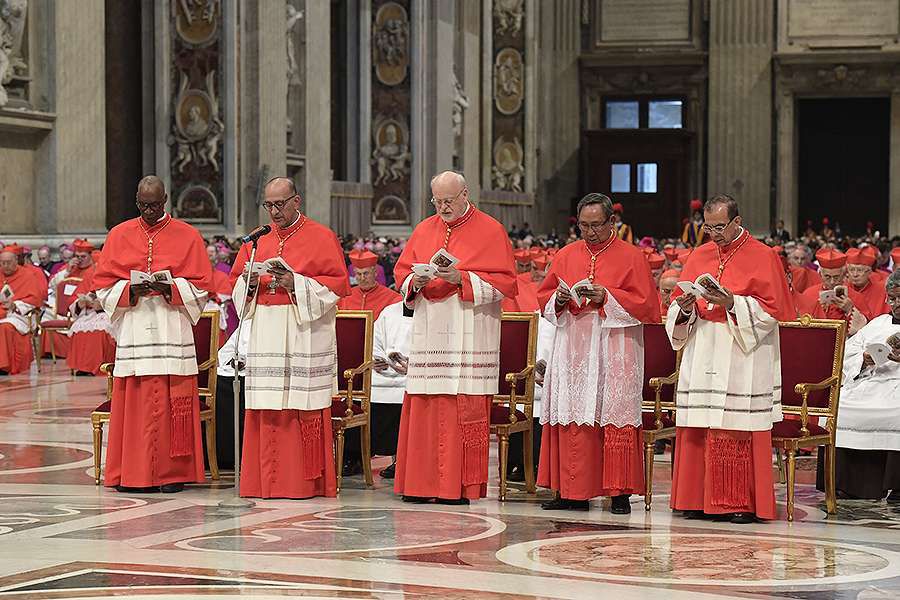Vatican City, Jul 1, 2017 / 04:35 am (CNA/EWTN News).- A consistory is a gathering of cardinals, which the Pope can convoke to give solemnity to a particular decision, or simply to ask his “Senate” to counsel him on an important issue. However, the most recent consistory, held June 28, was rather exceptional. Here are four reasons why.
A surprise consistory
The June 28 consistory was a real surprise: when Pope Francis announced it May 21, there had been none of the normal hints that he was going to call for one. For one thing, there were only a few open “slots” in the College of Cardinals. According to the norm set by Bl. Paul VI and confirmed by St. John Paul II, there can be only 120 cardinals who have voting rights in the event of a conclave to choose the next Pope (the primary responsibility of cardinals).
However, Pope Francis made the decision to create five new cardinals, so following this week’s consistory, there are now 121 cardinals with the right to vote in a future conclave, surpassing the normal limit of 120. He is not the first Pope to do so. St. John Paul II created 44 cardinals in the Feb. 21, 2001 consistory. This made 135 cardinals with voting rights, a full 15 over the limit set by Paul VI.
A small number of cardinals
Also unusual for a single consistory: Pope Francis created just five cardinals. Only one of them comes from Europe, while the other four come from countries that have never had a cardinal before: Mali, El Salvador, Sweden, and Laos. This consistory, to some extent, is similar to the final one convoked by Pope Benedict XVI, which took place Nov. 24, 2012. During that consistory, Benedict XVI created only six new cardinals, and none of them hailed from Europe: it was the first consistory since 1924 with no Europeans in the list of new cardinals. In 1977, Pope Paul VI convoked his final consistory, creating only four new cardinals. Among them was Joseph Ratzinger, who later became Pope Benedict XVI.
The visit to the Pope emeritus
Another interesting aspect to this consistory: the newly created cardinals, joined by Pope Francis, paid a visit to the former pontiff, Benedict XVI. Ever since Pope Francis has convoked consistories, the Pope emeritus has been taken into consideration and had some role in them. Benedict XVI took part in Pope Francis’ first two consistories for the creation of new cardinals, held Feb. 22, 2013 and Feb. 14, 2014. Though the Pope emeritus did not take part in the third of Pope Francis’ consistories, held Nov. 19, 2016, the newly created cardinals paid a visit to him in the Mater Ecclesiae monastery where he lives. This time the new cardinals were accompanied by Pope Francis as they paid a visit to Benedict XVI.
The lack of a pre-consistory meeting for a general discussion
ccording to the Code of Canon Law, there are two types of consistories: ordinary and extraordinary. All cardinals are called to take part in extraordinary consistories, which are celebrated only in particular cases. In contrast, ordinary consistories are summoned when the Pope needs the cardinals’ counsel on some issue, or to add solemnity to a decision by the Pope, for example the canonization of saints or the creation of new cardinals. Sometimes both types of consistories take place consecutively.
The first two ordinary consistories convoked by Pope Francis were preceded by extraordinary consistories, as the Pope took advantage of the cardinals’ presence in Rome to discuss important issues. The Feb. 22, 2014 consistory was preceded by an extraordinary consistory on the issues of the family, while the Feb. 14, 2015 consistory was preceded by an extraordinary consistory to discuss the reform of the Curia. In contrast, neither this week’s consistory nor the one that took place on Nov. 19, 2016 were preceded by pre-consistory meetings.

